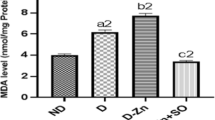Abstract
Previous studies have demonstrated marked alterations in trace metal metabolism in male Sprague-Dawley rats following chemical induction of the diabetic state. To determine whether such changes represented a general response to the insulin-deficient condition the levels of zinc, copper, and maganese in liver, kidney, and intestine of normal and streptozotocin (STZ)-diabetic male rats of the Sprague-Dawley, Wistar, and Long-Evans strains, female Sprague-Dawley rats, and male mice were measured. Significantly increased concentrations of zinc, copper, and maganese in liver, and zinc and copper in kidney were found in STZ-diabetic rats, regardless of sex and strain. In contrast, the zinc and copper contents in liver and kidney of control and STZ-diabetic mice were similar, but hepatic manganese levels were significantly elevated in both organs of the diabetic mouse. The concentrations of all three metals were similar in the intestine of control and diabetic rodents. Higher amounts of zinc and copper were bound to metallothionein in the liver and kidney of the diabetic rats. Nicotinamide injection prior to STZ administration protected rats against the development of diabetes and alterations in trace metal status. These data indicate that specific alterations in the metabolism of zinc, copper and manganese during episodes of pancreatic hormonal imbalance represent a general phenomenon in the rat. A possible explanation for the differential response of the STZ-diabetic mouse is discussed.
Similar content being viewed by others
References
G. W. Evans,Physiol. Rev. 53, 535 (1973).
H. N. Munro and M. C Linder,Physiol. Rev. 58, 317 (1978).
R. J. Cousins,Amer. J. Clin. Nutr. 32, 339 (1979).
R. I. Henkin,Med. Clin. N. Amer. 60, 779 (1976).
R. J. Cousins and M. L. Failla, inZinc in the Environment. Part II Health Effects, J. O. Nriagu, ed., Wiley, New York, 1980, pp. 121–136.
K. R. Etzel, S. G. Shapiro, and R. J. Cousins,Biochem. Biophys. Res. Comm. 89, 1120 (1979).
F. O. Brady,Life Sci. 28, 1647 (1981).
K. R. Etzel and R. J. Cousins,Proc. Soc. Exptl. Biol. Med. 167, 233 (1981).
C. G. Rerup,Pharmacol. Rev. 22, 485 (1970).
M. L. Failla and R. A. Kiser,J. Nutr. 111, 1900 (1981).
M. L. Failla and R. A. Kiser,Amer. J. Physiol. 244 (Endocnnol. Metab. 7), E115 (1983).
J. S. Bond, M. L. Failla and D. F. Unger,J. Biol. Chem. 258, 8004 (1983).
N. E. Craft and M. L. Failla,Amer. J. Physiol. 244 (Endocrinol. Metab. 7) E122 (1983).
A. L. Lau and M. L. Failla,Fed. Proc. 42, 823, (Abstract 3109, 1983).
M. L. Failla, N. E. Craft, and G. A. Weinberg,Proc. Soc. Exp. Biol. Med. 172, 445 (1983).
J. L. Bailey, inTechniques in Protein Chemistry, Elsevier, New York, 383, 1962.
F. O. Brady,Trends Biochem. Sci. 7, 143 (1982).
R. W. Olafson,J. Nutr. 113, 268 (1983).
S. Tauri,Endocrinol Japon. 10, 1 (1963).
G. Hallmans and F. Lithner,Upsala J. Med. Sci. 85, 59 (1980).
L. P. Grigorieva,Med. Radiol. (Moscow) 11, 41 (1966).
V. G. R. Constan, W. Leemann, F. Almasy, and A. G. Constan,Schweiz. Med. Wschr. 94, 1104 (1964).
H. G. Pidduck, P. J. J. Wren, and D. A. P. Evans,Diabetes 19, 240 (1970).
P. McNair, S. Kiilerich, C. Christiansen, M. S. Christensen, S. Madsbad, and I. Transbol, Clin. Chim. Acta112, 343 (1981).
H. Hirsch-Kobb, H. J. Kolb, and D. M. Greenberg,J. Biol. Chem. 246, 395 (1971).
Author information
Authors and Affiliations
Additional information
Submitted in partial fulfillment of requirements for the Undergraduate Degree “in Honors” in Biochemistry and Nutrition.
Rights and permissions
About this article
Cite this article
Spittle, S.A., Failla, M.L. Influence of sex, strain, and species on trace metal status of insulin-deficient diabetic rodents. Biol Trace Elem Res 5, 489–502 (1983). https://doi.org/10.1007/BF02988941
Received:
Accepted:
Issue Date:
DOI: https://doi.org/10.1007/BF02988941
Index entries
- Zinc
- status in diabetic rodents
- copper
- status in diabetic rodents
- manganese
- status in diabetic rodents
- metallothionein
- status in diabetic rodents
- diabetes mellitus
- and trace metal status in rodents
- streptozotocin
- insulin
- and trace metal status in diabetic rodents
- rats
- trace metal status in diabetic
- mice
- trace metal status in diabetic
- kidney
- trace metal status in diabetic rodent
- intestine
- trace metal status in diabetic rodent




